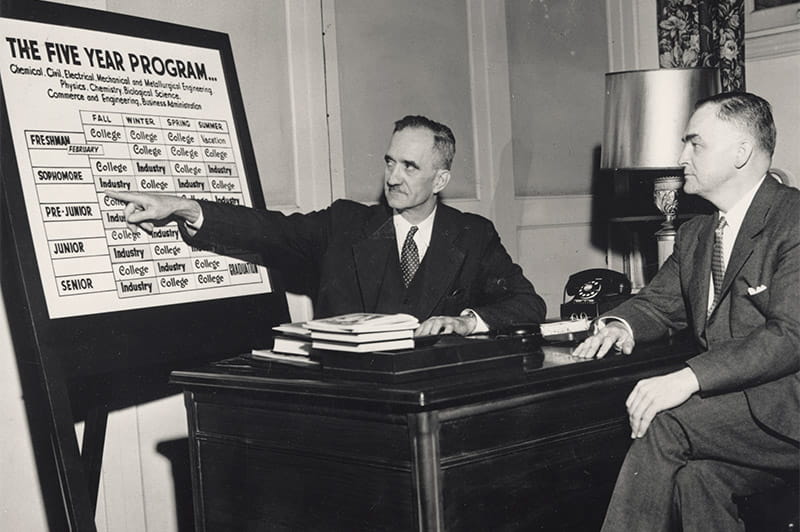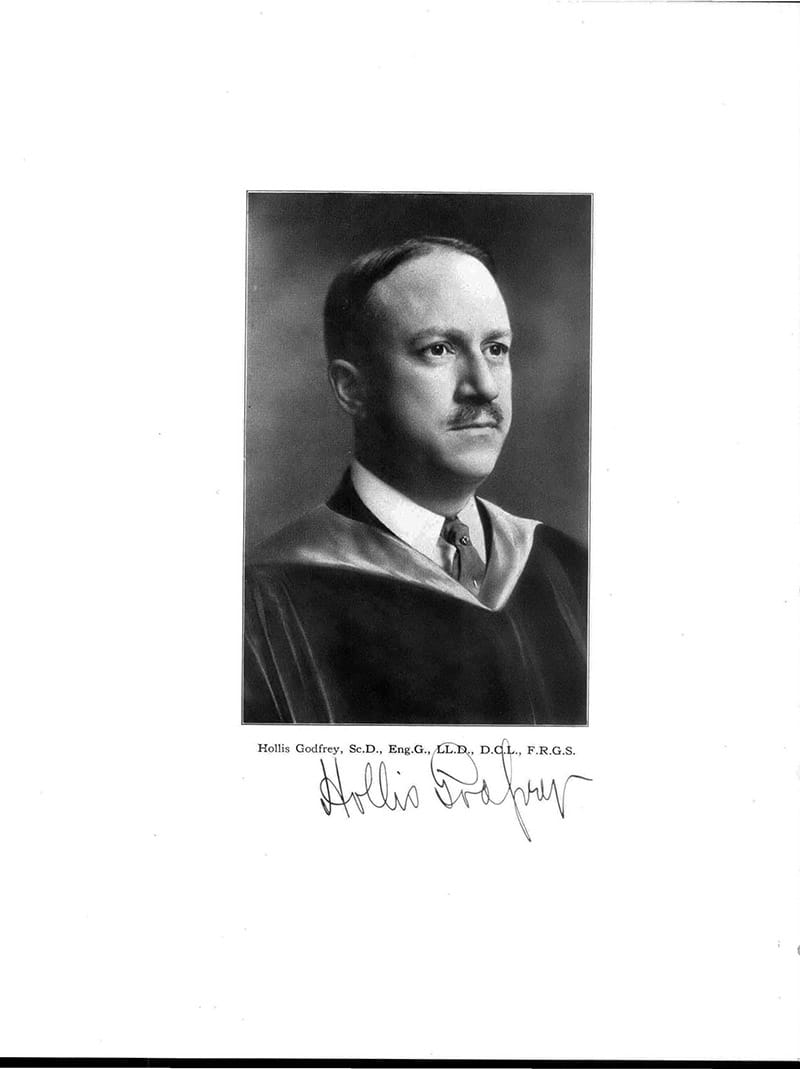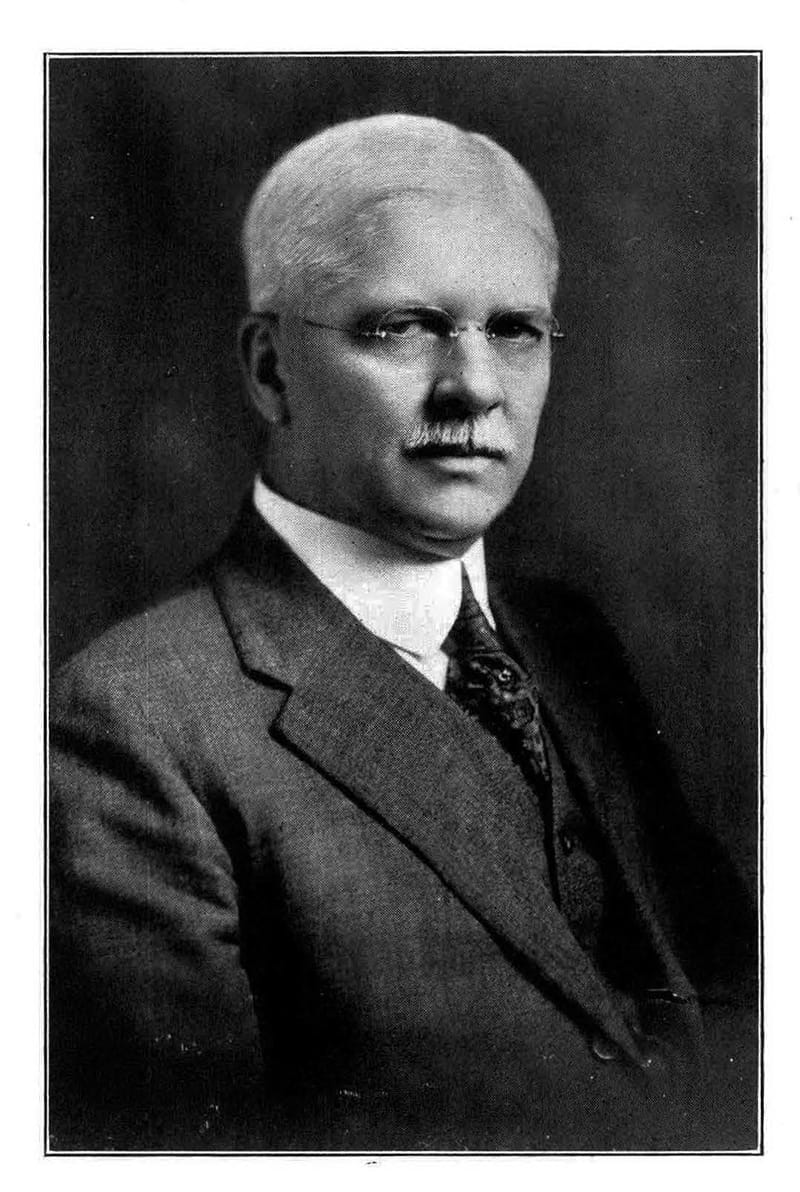How Drexel’s Co-op Got Made

This is one of a regular series profiling the Drexel Co-op program, which celebrates its 100th anniversary in 2019-2020.
Today, a key component of a Drexel University education is the Drexel Co-op, in which students rotate between months-long job placements and full-time classes to graduate with a résumé filled with professional experiences.
But this wasn’t always the case.
In fact, Drexel’s signature program was introduced in 1919, 28 years after the then-Drexel Institute of Art, Science and Industry opened. And in the subsequent 100 years, the program has grown from an introductory co-op class of 152 engineering students working at 5 local employers to over 5,300 students from all disciplines working with over 1,500 employers in 38 countries and 31 states (plus D.C., Puerto Rico and the Virgin Islands) in 2017–2018.
So how did Drexel’s co-op program get its start? It’s thanks to these three people:
- Drexel President Hollis Godfrey, ScD, EngD, who led from 1913 until he left in 1921.
- Drexel President Kenneth G. Matheson, ScD, who led from 1922 until he died in 1931.
- Director of the Department of Industrial Coordination and Professor Cecil A. Kapp, who oversaw the Drexel Co-op from 1922 until he retired in 1962.
1. The Man Who Made Drexel’s Co-op
When Hollis Godfrey started at Drexel in 1913, the 22-year-old institution was composed of more than a dozen autonomous departments, conferred neither degrees nor diplomas and had recently lost its first and only president, James A. MacAlister, who himself had recognized that Drexel had “not yet found [its] right place in the educational economy of the country, and it is not easy to define what that position should be.”
Godfrey was originally hired by Drexel as a consultant to find out what that position should be. A follower of Taylorism, or the theory of scientific management, Godfrey was an expert in maximizing efficiency through scientific principles, which he had applied to help the City of Philadelphia’s save money on its streetlights. His resulting plan for Drexel — which included organizing departments into schools and granting Bachelor of Science degrees — led to his hiring as its second president.

Co-operative education had been founded by Herman Schneider in 1906 at the University of Cincinnati. Under Godfrey, Drexel became one of the early adapters of the system and the first to implement it in Philadelphia.
The decision to introduce co-operative education at Drexel was influenced by Godfrey’s, and Drexel’s, experiences with World War I, even before America became involved. In 1908, Godfrey had achieved literary success with “The Man Who Ended War,” which the New York Times hailed as an “ingenious scientific novel;” the fictional, futuristic-sounding technology he invented to wipe out foreign fleets was so extraordinary that he was recognized as an expert in future weaponry. His engineering expertise shown in the book and his consulting work led to his appointment by U.S. President Woodrow Wilson as chief architect of the Council of National Defense, which was created in 1916 to apply scientific management principals to resources and industry. Drexel was also heavily involved in the war effort, as new curricula and programs were developed for students and its Army Reserve Officers’ Training Corps (ROTC) launched in 1918 to train men in technical fields for the war effort instead of sending them directly to the trenches. Godfrey thought that partnering with industry, the military and the government could benefit the country, and Drexel students, during and especially after wartime.
“This newly designed system of engineering education shows you how to make your services of more value to … your country, enabling you to fight more intelligently for the industrial democracy of our nation and to make complete the military victory we have won,” Godfrey explained in 1919.
Drexel’s co-operative education model was formally initiated that year as a four-year plan for mechanical engineering, electrical engineering and civil engineering students. But the first students wouldn’t go on co-op until after Godfrey left Drexel. In October 1921, he resigned to chair the newly established Council of Management Education to further partnerships and opportunities for colleges and industry to work together.
2. The Man Who Solidified Drexel’s Co-op
Godfrey’s successor, Kenneth G. Matheson, was brought to Drexel to boost its enrollment and expand its co-op system, both of which he had succeeded in doing as president of the Georgia School of Technology (today’s Georgia Tech) since 1906. Matheson turned the Drexel Co-op from an idea into a reality — one that still exists a century later.

Under Matheson, the first class of students completed co-ops. While he was president, the co-op expanded in programs (chemical engineering, commerce and engineering, business administration and retail management), length (the creation of five-year co-ops, in addition to four-year co-ops) and size. In the first 10 years of Drexel students going on co-op, enrollment expanded by 693 students and more than 65 local financial, commercial and engineering companies.
“Our long-established co-operative arrangement with business firms has built up a solid foundation for co-operative courses,” Matheson stated in 1928. “Executives of these firms welcome the co-operative business student because they know these two facts: First, that this course attracts only the more earnest and ambitious students; and second, that the co-operative graduate is trained to handle a man’s job—with full responsibility— from the day he graduates.”
That previous year, Matheson was elected the second president of the Association of Co-operative Colleges, which had been started the previous year and is today known as the Co-operative Education & Internship Association. The first president had been Schneider, the creator of the co-operative education model — a clear indication of Matheson’s and Drexel’s reputation and prominence in the field.
Just a year before Matheson would have celebrated a decade at Drexel, he died of a heart attack in 1931. It was a huge loss for Drexel, which had grown, developed and became tighter knit under his leadership. But the foundation Matheson had laid, particularly in regard to its co-op system, was key — especially because it would continue to be enacted by someone who had helped set it up.
3. The Man Who Grew Drexel’s Co-op
Cecil A. Kapp was no stranger to the co-operative education system — he was an electrical engineering graduate of the University of Cincinnati, the birthplace of the cooperative plan of education, and had been a pupil of Schneider. He had also worked at the Georgia School of Technology as an associate professor in the co-operative department, and Matheson brought him with him to Drexel to start its co-op program. Kapp later served as an honorary pallbearer at Matheson’s funeral.
At Drexel, he started as the new director of cooperative work and professor of co-operative education, building a newly formed office to partner Drexel with local organizations and coordinate co-ops between students and employers (a system still in place today through the Steinbright Career Development Center). Under Kapp’s leadership, many co-op programs were launched; in addition to the ones created during Matheson’s time, co-op programs in home economics, metallurgical engineering, physics, chemistry, biological science, math and life sciences were initiated. Graduate student co-ops were created toward the end of Kapp’s time at Drexel for students in electrical engineering, mechanical engineering and library science programs.
In his second and third decades at Drexel, Kapp guided the co-op program through times of unprecedented economic and employment uncertainty. During the Great Depression, Drexel responded to the massive economic layoffs by approaching smaller employers, extending the co-op work term and increasing co-ops in government agencies. Still, the number of students going on co-op peaked at 922 students in 1928–1929 before dramatically decreasing until the middle of the 1930s. Before and during World War II, Drexel also adapted its curriculum and programs to fit the war effort, offering additional training for men and women to support national defense. Co-op numbers also significantly dipped during this time: 1,468 students went on co-op in the 1941–1942 academic year, with 850 the next year and 198 the year after that.
After the war, the number of students, employers and programs bounced back. Kapp was in charge of what was then called the Department of Industrial Coordination, which, in addition to overseeing the co-op program, helped Drexel recruit high school students, place students on co-op and assist graduating seniors and alumni with landing jobs.
By the time Kapp retired in 1962, Drexel’s co-op employer network of 500 firms in 19 states was hiring over 4,000 students. He had expanded the Drexel Co-op over the course of a financial panic, a world war, a Drexel name change (the Drexel Institute of Art, Science and Industry became the Drexel Institute of Technology in 1936) and the terms of four different Drexel presidents (Matheson, Parke R. Kolbe, George Peters Rea and James Creese).
And Kapp accomplished this while overseeing the Drexel Co-op for 40 of its 100 years.
About the Drexel Co-op program: Nearly all eligible undergraduate students at Drexel University participate in the co-op program, balancing full-time classes and up to three different, six-month-long work experiences during their time at Drexel. Students can choose from hundreds of employers across the country and globally — plus endless possibilities through self-arranged opportunities.
In This Article
Drexel News is produced by
University Marketing and Communications.

